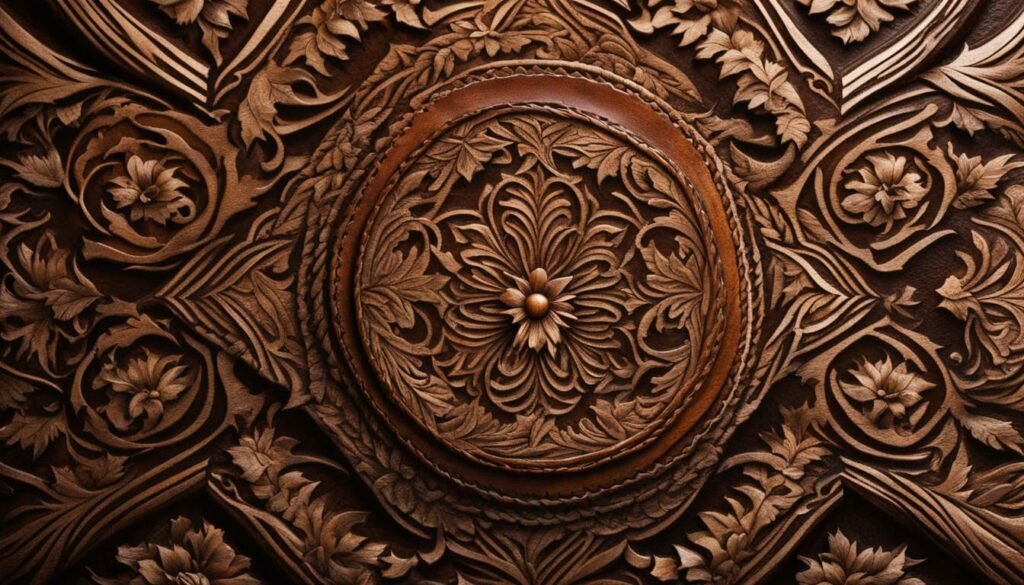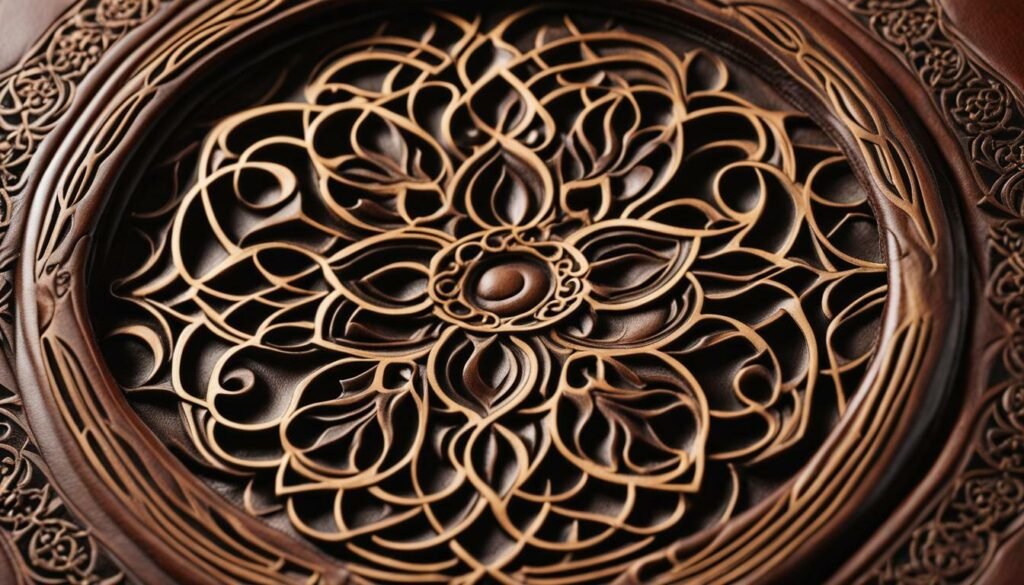With the right guidance and a willingness to learn, anyone can develop their craftsmanship and create luxurious leather items.
From mastering leather crafting techniques to exploring the art of leather tooling, we have everything you need to get started on your leatherworking journey.
- Leatherworking is an accessible craft for anyone with a passion for creativity.
- Developing your leatherworking skills is a journey that requires patience and dedication to the craft.
- Learning essential leather crafting techniques and mastering the art of leather tooling are crucial to creating beautiful leather goods.
- Choosing the right leather and using proper safety measures are essential to a successful leatherworking experience.
- With practice and perseverance, you can take your leatherworking skills to the next level and continue to grow and improve over time.

Getting Started with Leatherworking
If you’re new to leatherworking, it can be overwhelming to know where to begin. But don’t worry, we’ve got you covered with some helpful tips and tricks to get started on your leatherwork projects.
Choose Your First Project
Before purchasing any leather or tools, think about what project you’d like to start with. Choose a relatively simple project, such as a leather keychain or a cardholder, that only requires a few basic tools.
Invest in Quality Leather
The quality of your leather can greatly affect the final outcome of your project. Invest in high-quality leather that is appropriate for your project, and consider purchasing a leather sampler pack to experiment with different types and finishes.
Watch Tutorials
Before diving into your project, watch some leatherworking tutorials to familiarize yourself with the techniques and tools you’ll be using. There are plenty of leatherworking tutorials available for free on YouTube and other websites.
Get the Right Tools
While it can be tempting to buy every leatherworking tool and gadget available, focus on purchasing only what you need for your first project. A few essential tools include a cutting mat, rotary cutter, leather needles, and waxed thread.
Take Your Time
Leatherworking requires patience and attention to detail. Take your time with each step of the project and don’t rush through it. Remember, it’s okay to make mistakes – they can often be fixed with some creative problem-solving!
With these tips in mind, you’re well on your way to starting your first leatherwork project! Remember to have fun and enjoy the creative process. Keep practicing and experimenting with new techniques and projects to improve your leatherworking skills.

Leather Crafting Techniques
Leather carving and stitching are two essential techniques that every leatherworker should master.
- Leather carving involves cutting and shaping leather to create patterns and designs on the surface. You can use a swivel knife, a mallet, and a leather stamp to carve out intricate designs on your leather goods.
- Leather stitching involves joining two or more pieces of leather together using a needle and thread. You can use different types of stitches, like saddle stitch or whip stitch, depending on the type of leather and the project you are working on.
Choosing the right leather is essential for creating high-quality leather goods. Here are some leatherworking essentials to keep in mind when selecting your leather:
- Consider the type of project you are working on and the intended use of the finished product.
- Inspect the leather for any imperfections or blemishes, such as scratches, scars, or discoloration.
- Choose a leather thickness that is appropriate for your project. Thicker leather is better for items that need more structure and support, while thinner leather is suitable for more flexible projects.
- Decide on the finish you want for your leather. Different finishes can enhance or change the color and texture of the leather.
- Make sure to have essential leatherworking tools, such as a sharp knife or rotary cutter, a cutting mat, and a ruler or measuring tape, to ensure accurate cuts and measurements.

While working with leather can be a rewarding and enjoyable experience, it is important to prioritize safety to prevent accidents and injuries. Here are some leatherworking tips and tricks for staying safe:
- Always wear protective gear, such as gloves and eyewear, to prevent cuts and abrasions.
- Use sharp tools and equipment to avoid exerting too much force, which can lead to slips and injuries.
- Be mindful of your surroundings and keep a clean workspace to prevent tripping or slipping.
- Store sharp tools safely, such as in a designated toolbox or drawer, to avoid accidental injuries.
- Avoid using flammable materials or tools near an open flame or heat source to prevent fires or burns.

Designing Leatherwork Projects
Designing your leatherwork project is where the fun really begins. Here are some tips to get you started:
- Sketch out your design ideas on paper before you start carving to ensure you have a clear vision of what you want to create.
- Consider the size and shape of the leather you’re working with. This will impact the design you choose.
- Don’t be afraid to experiment with different carving techniques to create unique designs.
- If you’re unsure, start with simple designs and work your way up to more complicated ones.
- Take breaks and step back from your work periodically to ensure you’re happy with the overall design.
After carving and stitching your leatherwork project to perfection, it’s time to add the finishing touches that will make your creation stand out. Here are some tips and techniques to elevate your leather goods:
- Use a leather burnisher to smooth out and polish the edges of your leather
- Add a coat of leather finish to protect your work and give it a glossy or matte look
- Experiment with different types of leather dyes to add color and dimension to your work
- Add hardware, such as buckles or snaps, to create a functional and stylish accessory
- Consider adding a personalized touch with monogramming or embossing
Take your leatherwork projects to the next level by adding embellishments and decorative elements that will make them stand out. Here are some techniques to try:
- Carving: Use tools to create intricate designs and patterns in the leather surface. This technique adds texture and visual interest to any leatherwork project.
- Stitching: Experiment with different types of stitching to add depth and dimension to your leather goods. Try using contrasting colors of thread for a bold effect.
- Painting: Use leather paint or dye to add color and texture to your projects. This is a great way to add a personal touch to your leather goods.
As with any craft, leatherworking comes with its own set of challenges. Here are some tips and tricks to troubleshoot common issues:
- If your leather is too dry and hard to work with, try adding a small amount of neatsfoot oil to soften it up.
- To prevent wrinkling while stitching, make sure your leather is properly dampened.
- If you’re having trouble cutting leather straight, try using a metal straight edge or a leather cutting guide to keep your cuts even.
- If your stitching is too loose or uneven, try using a stitching groover to create a groove for your thread to sit in.
- To avoid holes in your leather, make sure your stitching awl is sharp and you are using the proper size needle for your thread and leather weight.

Now that you have perfected the art of leather carving and stitching, it’s time to add the finishing touches to your leatherwork projects. The final touches can make all the difference in the overall look and feel of your leather goods.
- Consider adding a protective coat of leather finish to your project to keep it looking pristine for years to come.
- Experiment with different dye colors and finishes to achieve the perfect look for your project.
- Try adding hardware such as buckles or clasps to give your project an extra touch of personality.
Congratulations on honing your leatherworking skills! Now that you have mastered the basics, it’s time to continue your leatherworking journey and explore new tips and tricks to take your craftsmanship to the next level.
Here are some leatherworking resources to keep you inspired:
- Join leatherworking forums and communities to connect with other leatherworkers and learn from their experiences
- Subscribe to leatherworking magazines and blogs for the latest trends, tutorials, and industry news
- Invest in advanced leatherworking courses to expand your skills and explore new techniques
- Attend leatherworking conferences and expos to meet fellow leather enthusiasts and discover new products and tools
- Experiment with different leather types, colors, and finishes to push your creativity and expand your leatherworking portfolio
FAQs
What are leatherworking skills?
Leatherworking skills refer to the techniques and abilities required to work with leather and create various leather goods. This can include skills such as leather carving, stitching, tooling, and more.
How can I develop my leatherworking skills?
Developing your leatherworking skills can be achieved through practice and learning from experienced leatherworkers. Taking leatherworking tutorials, experimenting with different techniques, and seeking out resources can help you enhance your craftsmanship.
What leather crafting techniques should I learn?
Some essential leather crafting techniques include leather carving, stitching, embossing, and tooling. These techniques allow you to create intricate patterns, add texture, and bring your leatherwork projects to life.
What is leather tooling?
Leather tooling is the process of creating decorative designs and patterns on leather using specialized tools. This technique requires precision and creativity to add unique details to your leather goods.
How do I choose the right leather for my projects?
Choosing the right leather involves considering factors such as the type of project, desired durability, and texture. It’s important to select high-quality leather that is suitable for your specific needs to achieve the best results.
What are some leatherworking safety tips?
When working with leather, it’s important to prioritize safety. Some safety tips include wearing protective gloves and eyewear, using sharp tools carefully, having a well-ventilated workspace, and keeping your tools and materials organized to avoid accidents.
How can I design leatherwork projects?
Designing leatherwork projects involves planning and sketching out your ideas before starting. You can use tracing paper to transfer designs onto leather and practice carving or stamping techniques to create intricate patterns.
How can I add finishing touches to my leatherwork?
Adding finishing touches to your leatherwork can include techniques such as stitching, burnishing edges, applying dyes or finishes, and polishing. These final touches enhance the overall appearance and durability of your leather goods.
What are some embellishment and decoration techniques for leatherwork?
Embellishment and decoration techniques for leatherwork can include carving intricate designs, adding decorative stitching, and incorporating metal or leather accents. These techniques add texture and visual interest to your leather goods.
How can I troubleshoot common leatherworking challenges?
Common leatherworking challenges can include issues with stitching, tooling mistakes, or uneven dye application. Troubleshooting tips can include using leather conditioners to fix mistakes, adjusting stitching techniques, or experimenting with different tooling methods.
How can I take my leatherworking skills to the next level?
Taking your leatherworking skills to the next level involves expanding your knowledge through advanced tutorials, experimenting with new techniques, and seeking out additional resources such as books, workshops, or online courses.
How can I showcase my leatherwork?
Showcasing your leatherwork can be done by displaying your finished projects in a well-lit area, using proper stands or racks, and capturing high-quality photographs to share on social media or personal portfolios.
How can I continue my leatherworking journey?
Continuing your leatherworking journey involves staying inspired and seeking out new challenges. You can join leatherworking communities, attend workshops or conferences, and explore new techniques and projects to keep growing as a leatherworker.
